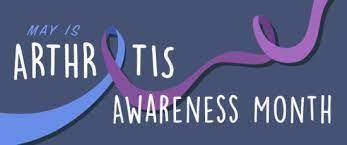Assembled by Amanda Ballard, executive assistant and communications coordinator
Sources: cdc.gov, nationaltoday.com, healthri.gov
The month of May is recognized each year as National Arthritis Awareness Month. People are encouraged to wear blue to support awareness of a disease that affects nearly one-quarter of all U.S. adults. The significance of this observation is to bring attention to a condition that affects more than 53 million Americans and is expected to exceed 67 million by the year 2030.
What is it?
Arthritis is a general term for conditions that affect the joints or tissues around the joint. There are more than 100 types.
Most cause pain and stiffness in and around the affected joint or joints. Some types of arthritis, such as rheumatoid arthritis, also affect the immune system, and some internal organs of the body. 
- Osteoarthritis
- Rheumatoid Arthritis
- Gout
- Fibromyalgia
- Childhood Arthritis
- Lupus
What are the symptoms of arthritis?
Different types of arthritis have different symptoms. Pain and stiffness in and around one or more joints are common symptoms for most types. Symptoms can develop suddenly or gradually over time. They may come and go, or persist over time.
What causes arthritis?
Experts don’t know the causes of many forms of arthritis. However, it is known that gout is caused by too much uric acid in the body. Sometimes specific infections can also cause arthritis.
Scientists are studying the role of factors such as genetics, lifestyle, and environment in different types of arthritis to learn more possible causes and risk factors.
Options for Treatment?
As it is a chronic (long-term) condition, there is no “cure,” but symptoms can be managed. It all starts with lifestyle changes; these include getting enough exercise, changing eating habits, and making sure one has enough physical activity throughout the day. A doctor may prescribe anti-inflammatory drugs, corticosteroids, and physical and occupation therapy to try to improve a person’s range of motion.
Others advise to get moving! Whether one lives in a rural area, suburb, or urban neighborhood, walking has been shown to improve arthritis pain, fatigue, function, and the quality of life. There is no better time to begin a walking program or recommit to a walking routine than during Arthritis Awareness Month.
All adults, including adults with arthritis, should get 2 hours and 30 minutes (150 minutes) of moderate-intensity aerobic activity (i.e., brisk walking) per week and do muscle-strengthening activities two or more days a week, according to experts.
5 foods to help fight arthritis
1. Tart cherries– They offer powerful anti-inflammatory and antioxidant benefits — providing joint pain relief, while lowering the risk of flares in those with gout.
2. Colorful vegetables– Think sweet potatoes, carrots, red (or green) peppers and squash. Peppers, especially, are an abundant source of vitamin C, which preserve bones, and may protect cartilage.
3. Seafood- The best? Salmon, tuna, sardines, and mackerel. They can all help decrease inflammation and protect the heart. Look for frozen or canned fish to save money.
4. Walnuts- They’re high in alpha linoleic acid (ALA), a type of anti-inflammatory omega-3 fatty acid. Eating walnuts regularly can also lower cholesterol, relax blood vessels, and reduce blood pressure
5. Garlic- It can help fight pain, inflammation, and cartilage damage. If possible, try for fresh garlic to avoid unwanted preservatives and processing — which could decrease the benefits.
How can you help someone with arthritis?
• Plan beneficial exercises together
• Join them in hand moves to reduce joint pain
• Do yoga or other gentle stretches
• Explore stress-reduction activities to help support a loved one
• Join a family member with RA in progressive muscle relaxation
• Encourage friends and family members With RA to sleep well



